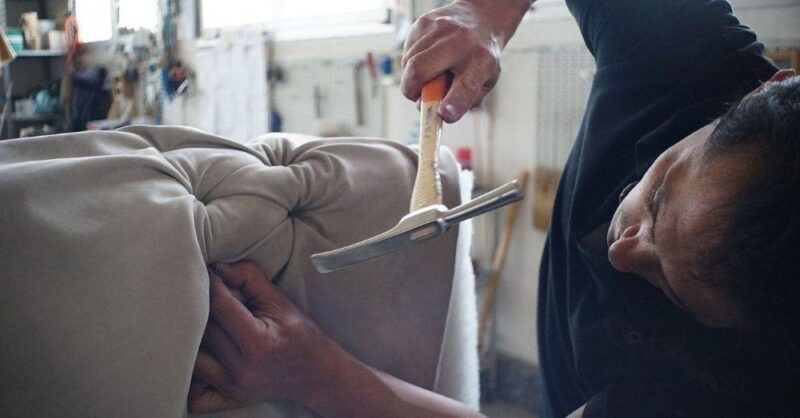
Furniture inventory management software
Furniture and home decor is a consistently competitive business. Don’t let software hold you back from success, choose Katana and get ideal inventory management, brilliant bills of materials, and total sales control so you always have happy customers.
Features
Furniture inventory management features
Building products for the furniture and home market needs accuracy, consistency, and time. Katana’s furniture inventory software helps you master all of them.
Total inventory control, automated reordering and moving average cost help keep your furniture business moving fast
Furniture inventory management software is crucial to building a successful business supplying people’s homes with interior fixtures. You need strict inventory control, well-structured bills of materials, and solid customer management to keep things running smoothly and meeting expectations. Katana is ideal for this purpose, as our software allows you to manage your stock across multiple locations and in the units and customizations you need. You can also specify reorder points for all items so stock levels remain consistent no matter how many orders you’re receiving.
Finally, moving average cost allows you to get an overview of your spending throughout your time using Katana, so you’re aware of the typical price for all of your goods and can price your products accordingly.

Detailed product control with accurate bills of materials
Along with swift sales and accurate accounting, quality management and setting customer expectations are key to success in the furniture field.
An accurate bill of materials (BOM) for every product plays a crucial role in this, with the option to add notes and instructions for each product if you have a team in your warehouse or on a shop floor.
Katana’s furniture inventory software enables you to:
- Create and edit bills of materials as needed
- Add notes and customizations to inform your shop-level teams of any necessary changes
- Prioritize orders based on material and product availability to get popular items shipped out faster
- Create reorder points for materials and supplies to avoid stockouts and delays
Build custom workflows based on your business needs
Katana has many useful features to enhance efficiency in your inventory operations and business tasks.
To further boost your success and streamline other day-to-day processes, we offer native as well as third-party integrations that centralize all aspects of your business into one unified platform.
Use Katana’s integrations to:
- Keep up with your finances and accounting
- Track and handle sales via e-commerce channels
- Create automations to improve productivity
- Organize your customer data with CRM services
Get a demo and see Katana in action
- Eliminate stockouts with Katana
- Easily manage incoming orders from all your sales channels
- Track products available for sale
Explore Katana’s power with our Free Plan
- No credit card needed
- Includes all of Katana’s core manufacturing features
- Unlimited users and integrations, with up to 30 SKUs and 3 inventory locations
Integrate with the best e-commerce, accounting, reporting, and CRM software out there
Create custom API integrations
Use Katana’s open API to create custom workflows and connect to apps beyond our list of integrations. Automate data transfers between the services you use to level up efficiency. Take a look at our API documentation to learn more.
Furniture inventory management software FAQs
Furniture inventory refers to the detailed list or database of all furniture items that a furniture business, such as a retailer, manufacturer, or rental service, has in stock or assets for sale, lease, or production.
This inventory encompasses a wide range of items, including but not limited to:
- Sofas
- Chairs
- Tables
- Beds
- Dressers
- Desks
- Outdoor furniture
The specifics of furniture inventory include several key attributes for each piece of furniture, which are crucial for sales, stock management, and customer satisfaction.
Here are some detailed aspects of furniture inventory:
- Item description — Each piece of furniture in the inventory is typically accompanied by a detailed description, which may include its design, dimensions, color, material, brand, and any unique features or craftsmanship details
- Stock levels — It’s essential to track the quantity available for each item for sales forecasting, replenishment ordering, and managing customer expectations regarding delivery times. This includes any items that are on backorder or being manufactured
- SKU numbers — Furniture items are often assigned unique stock-keeping units (SKUs) for easy tracking and identification. These SKUs are essential for inventory management, especially in systems that track sales, returns, and restocks in real-time
- Condition — Furniture inventory tracking also notes the condition of each item, which is particularly important for businesses that deal in used goods or rentals. Conditions can range from new, like-new, refurbished, to various grades of used conditions
- Location — For businesses with multiple locations or showrooms, the inventory system specifies the location of each item, facilitating quick retrieval and efficient logistics management
- Pricing information — Pricing details can vary based on the item’s condition, rarity, brand, and market demand. Documenting this information is crucial for sales personnel and for automating sales processes online or through point-of-sale systems
- Photographs and visuals — High-quality images or even 3D models of furniture items are often part of the inventory, especially for businesses that sell online. These visuals help customers make informed purchasing decisions and support sales strategies
- Historical data — Furniture inventory can also track historical data, such as sales trends for particular items, seasonal fluctuations in demand, and the lifecycle of each product. This data is invaluable for strategic planning, marketing, and product development
Managing furniture inventory involves balancing a wide range of factors, from maintaining sufficient stock levels to meet demand without overstocking to ensuring the inventory mix aligns with current design trends and customer preferences. Effective inventory management can significantly impact a furniture business’s operational efficiency, customer satisfaction, and overall profitability.
For a furniture dealer, a perpetual inventory system would be highly suitable.
This system continuously tracks inventory levels in real time, allowing for immediate updates to inventory records whenever a purchase or sale occurs. This approach is beneficial for furniture dealers for several reasons.
- Complex inventory needs — Furniture inventory is typically high-value with a wide variety of products, styles, and sizes. A perpetual system allows for detailed tracking of each item, including its specific characteristics such as color, material, or style
- Live tracking — It provides real-time information on stock levels, helping businesses avoid overstocking or stockouts. This is particularly useful for furniture dealers who need to manage their warehouses efficiently and respond quickly to consumer trends
- Supply chain management — Furniture dealers often deal with long lead times for receiving new inventory due to production and shipping constraints. A perpetual inventory system helps in planning orders and managing supply chain issues more effectively by providing up-to-date inventory information
- Customer satisfaction — This system can enhance customer satisfaction by ensuring that popular items are well-stocked and available for immediate delivery. It can also help in quickly locating specific items in the inventory, providing accurate information to customers regarding availability and delivery times
- Financial reporting and analysis — Perpetual inventory systems are often integrated with accounting systems, offering accurate and timely financial reporting. This helps furniture dealers monitor their financial health closely, make informed business decisions, and plan for future growth
Implementing a perpetual inventory system often requires an initial investment in technology, such as inventory management software and possibly hardware like scanners and RFID tags. However, the efficiency gains, improved accuracy in stock levels, and better customer service can significantly outweigh these costs over time.
This can depend on how big your business already is, but once you’ve customized the basic settings to your liking, you should be able to get up and running in a matter of days. Check out our Knowledge Base for materials and training videos to help you through the early stages, where you can learn about our inventory control options, custom fields, vendor integrations and much more.
We also offer onboarding support to help new customers kickstart their Katana experience faster. Our professional onboarding specialists can help you with migrating data, selecting and integrating any software you need, and setting up the best workflows for your business specifics.
Katana has native integrations with Shopify and WooCommerce that allow connecting to your online store. Shopify also supports POS sales while still syncing with the Katana database.
There are also third-party integrations, like Etsy, eBay, and Amazon, or you can connect to another platform using Katana’s open API.
Use Katana + integrations, and the world is your oyster.
Get visibility over your sales and stock
Wave goodbye to uncertainty by using Katana Cloud Inventory for total inventory control
